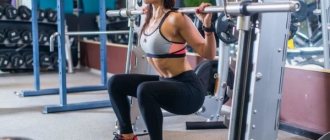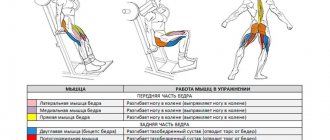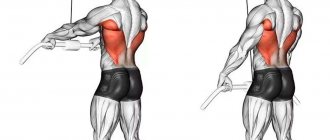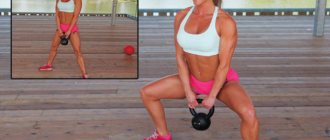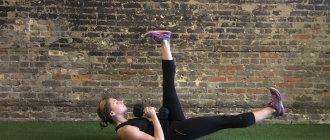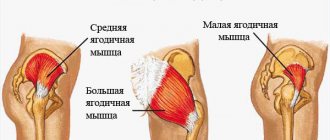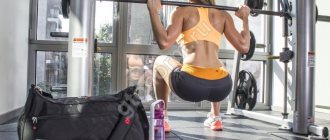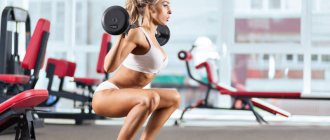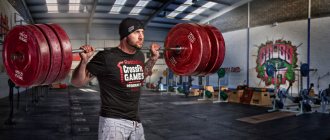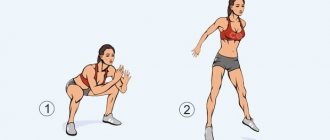Wide squats train the muscles of the legs and back. The work includes the inner and front surface of the thigh, buttocks and lower back. Squats with wide legs have several options.
The target muscles in the exercise are the inner thigh.
Alternative (similar) exercises:
- Leg press with wide stance.
- Plie squats.
- Leg curls in the simulator.
Barbell technique
- Starting position: the bar is located on the trapezius muscles, the grip is wide, the legs are spaced wide apart. Elbows should be turned to the sides. The press should be tense throughout the entire approach. Your hips should be turned out to the sides. The knees should be turned in the same direction as the feet, namely 45 degrees outward.
- The movement begins with inhalation: the legs bend at the knees, the pelvis is pulled back. The lowest point of the amplitude is reached at the moment when a right angle is formed in the knee joints (the thighs should be parallel to the floor).
- From the lowest point of the amplitude, you need to return to the starting position smoothly without jerking. The upward movement is performed while exhaling. The body weight should be transferred to the heels.
Squat technique
Without long introductions. Basic questions about squats:
— Positioning of the feet (wider, narrower, shoulder-width apart);
— Reversal of feet (has anyone even thought about this?);
— Emphasis on the heels/toes (which is correct?);
— Squat depth (the most controversial issue);
— Position of the knees (can the knees go beyond the toes?)
— Bend in the lower back (“butt wink” or when “the butt bites”);
- and a couple more nuances.)
- Positioning the legs.
The standard position of the legs when squatting is shoulder-width apart (1), or slightly wider (2). There is a dependence on height; as a rule, the taller the person, the wider the legs need to be placed in order to minimize the unwanted movement of the knees forward (beyond the toes) when squatting.
If we start from muscle work, then:
- with a wide stance: the back of the thigh, gluteal muscles, and inner thigh work more.
Separately about quadriceps. They also work with a wide stance, but the wider we place our legs and the more we turn our feet outward, the more the load shifts to the muscles of the inner thigh.
- with a narrow stance of the legs , the quadriceps is loaded more.
Bottom line: if you want to work the gluteal and inner thigh muscles, use a wide stance. If you want to work your quadriceps and outer thighs, use a narrow foot stance.
- Stop reversal.
Everything is simple here, the wider the position of the legs, the more you need to turn your feet outward. Why? When squats, the knees not be brought together with an X, otherwise this will lead to injury to the knee joint.
An example of an incorrect, “X-shaped” knee position when squatting/running:
- Emphasis on the heels.
One of the indicators that your technique and foot placement is correct is when the weight of the body/barbell presses on the heels and on the outer edge of the foot. If the weight presses on the toes, then a dangerous load is created on the knees. In this case, you need to adjust the weight of the barbell, the position of your legs, the tilt of your body, and perhaps change your shoes to more comfortable ones (flat-soled shoes are good for squats).
- Bend in the lower back.
When squatting, it is important to maintain a slight curve in the lumbar region. In this way, we transfer the load from the back to the gluteal muscles, forcing them to work as an extensor of the body.
Another point that is quite common during a “deep” squat is the tuck of the pelvis (“butt wink” or when the butt “pecks”).
Pelvic inversion may be associated with poor flexibility, tightness of the hip muscles, etc. This is a fairly common phenomenon, and in general it is not so terrible if the pelvis tucks in a little, but the back remains straight . But if the back is rounded, the load on the spine increases significantly, which can ultimately lead to injury.
Therefore, the main advice is not to lose the curve in the lower back when squatting. Sometimes it is better not to squat too deeply in order to maintain a natural curve, so as not to “drop your pelvis”.
- Squat depth.
This is the most controversial issue. And here I would recommend starting from your goals. If you are a professional athlete, then you probably have no choice, because... this moment is strictly regulated. But if you work out in the gym for yourself, then the depth of the squat should be determined by your technique . That is, if you can squat “deeply” and at the same time maintain the correct technique (head looks forward, straight back, pelvis does not peck, knees do not come together, emphasis on the heels), then great, a deep squat is completely suitable for you. But if your technique deteriorates with a deep squat, then it is better to abandon it.
What are the benefits of deep squats? Greater range of motion, more load on the muscles, and therefore better growth. But on the other hand, you can take more weight, reduce the range of motion (for example, squat until parallel to the floor) and still get the same load on the muscles. So, I repeat once again - the main thing is that the depth of the squat does not worsen your technique.
Perhaps the ideal option is a deep squat, with good technique (we sit down by moving the pelvis back, the torso is not tilted forward too much, we do not place the chest on the knees, the back is straight) and correctly selected weight (the maximum weight at which you still maintain the correct technique , and strain and stretch the gluteal muscles as much as possible). But this is ideal.)
An example of two correct variations of a deep squat:
- Knee position (can knees extend beyond toes?)
The general rule is “ when squats, your knees should not go beyond your toes .” If you are taller than average, you will need to place your feet a little wider to minimize unwanted knee padding/pushing forward (beyond your toes) when squatting.
The exception is deep squats (butt to heels). When doing a deep squat, your knees MUST extend beyond your toes, otherwise you'll end up arching your back, which is much more dangerous.
An example of when your knees MUST extend beyond your toes:
Once again I will return to the rule - “when squats, the knees should not go beyond the toes.” First of all, it is relevant for beginners, because... when we control our knees, the pelvis automatically moves back, the weight is transferred from the toe to the heel - this is exactly what is needed. Therefore, it is easier for a coach to say once, “watch your knees,” than to explain all the nuances (this is where the rule about knees came from; if you want, you can call it a myth). Remember that first of all you need to keep a straight back, your knees can go beyond your toes and in some cases must go out, otherwise you will not stand up with a straight back.
- Bringing your knees together when lifting.
A fairly common mistake in squats is bringing the knees together when lifting with an X. This can be due to incorrect positioning of the legs, if we do not point our toes out far enough, and it may also indicate insufficient development of the inner surface of the thigh. The wider the position of the legs, the greater the load on the inner thigh. If the muscles are weak, then the body transfers the load to the quadriceps, bringing the knees together with the X.
Once again I will return the picture with the “X-shaped” position of the knees when squatting/running:
The advice here is simple, experiment with positioning your legs, take lighter weights, develop your inner thighs (to help - squats with wide legs, side lunges).
- Smith machine and hack machine squats.
Very often, trainers in the gym put beginners to squat in a Smith or Hack machine. Firstly , it’s easier to install the equipment this way, and secondly, there ’s less need to explain.
But there are also negative aspects. Some call the Smith machine and the Hack machine a conveyor belt for “killing” the knees. When we squat in a hack machine (or in a Smith machine), the knees are pushed forward strongly, dropping below 90 degrees, the femur tends to move forward relative to the shin bones (and only the ligaments that prevent the femur from finally moving out of the joint). The second point is that when we squat in Smith and place our feet far forward from the bar, our back is in a very vulnerable position. Therefore, in general, general recommendations for these simulators are partial amplitude (in which even natural movement is close to a straight line), small weights and use the simulators at the beginning of the journey, or later for warming up.
If you are not a beginner, then I recommend moving away from squats in Smith:
Still, free weights are better, as they allow you to move along the path that is most natural for your body.
PS
And further…
— If you feel discomfort , especially pain (not muscle), then it’s better not to do it ;
— Squats also train the core muscles, and these include the abdominal muscles, so many people do not train the abs separately;
— When doing squats, intra-abdominal pressure increases (therefore, they are not recommended for pregnant women). If you cannot control your stomach when doing squats with heavy weights (your stomach should be pulled in), then wear a special belt;
— When squats, the bar should not lie on the neck , it should be lowered slightly to the shoulder blades.
— The most vulnerable position for the knees is a 90-degree angle at the knee joint. Squats to “parallel to the floor” are the most traumatic, since the entire load (stopping the weight, dead point) falls on a 90-degree angle in the knees (although many consider the most traumatic option to be a deep squat);
maximally load the gluteal muscles in squats, you need to make a more acute angle in the hip joint (see the picture below, the option on the left, by the way, pay attention to the correct position of the barbell on the back, and the position of the barbell relative to the feet);
— If the goal is to “round your butt,” then in addition to squats, there are a lot of effective exercises, which I examined in detail.
5 1 vote
Estimate
See also:
- Where do the lost kilograms of fat disappear?
- How muscles work
- Exercises and female breasts.
Projectile options
Wide-legged squats can be performed with different sports equipment: one or two dumbbells, a kettlebell or kettlebells. These projectiles are held in straight hands in front of you.
Wide squats with dumbbellsWide squats with kettlebell
There is also a variant of the exercise in the Smith machine, where the bar is located on the shoulders.
Narrow leg squats
pros
- Improved glute work.
- Development of coordination and sense of balance.
- Well-developed relief of the leg muscles.
- The ability to improve strength in classic squats.
- Focus on the outside of the quadriceps.
There is an opinion that squats with a narrow leg position emphasize the outer side of the quadriceps and thus benefit from regular squats. Alas, studies using electromyography did not confirm this hypothesis. Therefore, we did not mark this point as an advantage.
Minuses
- Increased load on the knee joints. The exercise is prohibited for older athletes, athletes with knee diseases or a history of injury.
- Due to the high load on the knees, it is better not to use the exercise for longer than a month and a half .
- With narrow foot placement it is easy to lose balance . Therefore, the exercise is not recommended for beginners. Even for advanced athletes, it is better to hone their technique in the first couples with an empty bar or no weight at all. Only then can you begin to exercise, and it’s best to do it in a Smith machine. It is more difficult to lose balance and get injured.
How to implement it into training
- If we are talking about women , then this exercise may be the first in the complex for the legs, but it must be performed infrequently and alternated with the usual position of the legs.
- Men should perform it after training the front of the thigh, for example, by performing classic and front squats. The execution scheme consists of three to four approaches and ten to twelve repetitions. The first approach should definitely be done without weight and warm up the ligaments and muscles before doing this.
Muscle work
Wide sumo squats distribute the load on the muscle groups of the lower body somewhat differently than classic squats.
Sumo-style squats are most useful for girls, as they work the inner thighs.
Muscle work looks like this:
- The adductors are the muscles of the inner thigh.
- Quadriceps are the muscles on the front of the thigh.
- The gluteus maximus is the muscle responsible for the shape and size of the buttocks.
- Additionally, the work includes the hamstrings (back surface).
- The calf muscles, back and abs stabilize the position.
As already mentioned, this exercise is primarily recommended for girls. It helps to correct the problem area (hips on the inside), tighten the muscles of the buttocks, and make the legs slender and attractive.
Recommendations
- For better results from the exercise, you can squat deeper.
- For balance, you can place the bar below your trapezius.
- The width of the legs and the depth of the squats must be selected individually. These nuances depend on stretching and flexibility, as well as the characteristics of the joints.
- A short pause should be maintained at the lower part of the amplitude.
- The load (body weight) should be transferred to the heels.
- Perform the exercise as concentratedly and slowly as possible.
- Your gaze should be directed forward while performing. The head should not be raised or lowered.
- The ideal option to ensure safety is to use a weightlifting belt.
- This exercise should not be done more than once a week for men and once every two weeks for women.
For beginner athletes, the best option would be to perform the exercise with a light dumbbell.
Why pump your legs at all?
This question is asked by any girl who decides to take her body seriously. If we recall the last decades of the 20th century, one of the features of bodybuilders of that time was an emphasis on the development of the upper body and a lenient attitude towards working out the leg muscles.
Fortunately, today the balance has been restored. The vast majority of training people are aware that it is impossible to have harmoniously developed body muscles if the legs are clearly lagging behind, creating a visual feeling of disproportion.
In addition, the basic rule of strength training is known: if you want big biceps, pump up your legs. After all, it is heavy approaches to large muscle groups that create an optimal hormonal background for anabolism in the body.
Impact on the lower back and knees
Injured athletes and people with hyperlordosis should be conscious about squat training. Many people should not perform squats, at least until full recovery has been achieved.
The movement itself is not dangerous to the lower back and knees, and with weights no greater than your own can be performed without benders, bandages, or a belt.
To prevent injury, you need to pay attention to:
- Press work . The stomach should not fall forward and be relaxed. The belt push is performed only if the athlete does power squats; it should be avoided in fitness;
- Initial position of the pelvis . There is no need to stretch your buttocks upward, as we often see in photos from fitness magazines. It looks beautiful, but is very traumatic for the lower back;
- The position of the knees . They move in the plane of the foot, towards the toes, rather than inward;
- Ankle mobility . If your shin is “clogged” from walking in heels or trying to pump up your calves, you should roll it with a roller and stretch it a little before you start squatting.
And the most important thing!
- Use squats with significant weights
only if your knees are perfectly healthy. If you feel clicking or any sensations in your knees that create discomfort, examine the condition of your joint in a medical facility and consult with a specialist. This doesn't mean you can't squat from now on. Simply discovering a problem may require reducing the weight, changing technique, or temporarily replacing the squat with another exercise. - Never squat through joint pain. Do not use bandages or warming ointments to reduce pain. You will only make the problem worse.
- Be sure to cycle the load. Vary microcycles with low, medium and high load. This will ensure normal regeneration and reduce the risk of under-recovery in the event of possible microdamage to joint elements.
Happy squatting, strong muscles and healthy knees! Train smart, not too much!
What are the benefits of squats for girls?
- Helps burn fat.
- Tones muscles.
- Increase muscle strength.
- Improves quality of life.
- Improves endurance.
- Prevents injuries.
- Helps cleanse toxins.
- Improves blood circulation.
- Helps get rid of cellulite.
- Increases flexibility.
- Improves posture.
- Strengthens bones and joints.
In conclusion, anyone can squat, but your main goal is to do it correctly. Follow the instructions to master this simple yet highly effective exercise. So, get up and squat to get a fabulous and lean body!
The main exercise for the lower body
Let's look at the factors that make squats one of the most effective exercises for building an athletic figure. The main advantage is that this movement is physiologically natural, and also allows you to use the maximum number of muscles, including the gluteal and inner thighs, which are traditionally problem areas of the body in women and often lagging behind in men.
In addition to the obvious benefits for training target muscles, as mentioned above, squats release the main anabolic hormone - testosterone - into the bloodstream. It makes a real man out of a male individual, with all his classic characteristics, including psychological and behavioral characteristics. This hormone is also important for the growth of muscle mass and the reduction of subcutaneous fat. Thanks to it, a person has libido - sexual activity of both men and women is directly proportional to the optimal level of testosterone in the body.
Squats also intensify the production of somatotropin (growth hormone), which ensures the regeneration of all tissues consisting or having connective tissue structures. First of all, these are ligaments, tendons, joints, blood vessels and skin.
Tips for implementation
To get good results from the exercise, focus on working the muscles, namely your glutes and thighs. The number of approaches and repetitions, although important, is still in second place.
Sets and reps
In order to get slender legs and firm buttocks, you need to build up some muscle. Yes Yes exactly. But don't be afraid to overpump, because this is unlikely to happen.
To achieve muscle growth, you need to work in the range of approximately 8-12 repetitions at a moderate pace (so that the exercise lasts 30-40 seconds).
The same interval is good for losing weight, but coupled with proper nutrition.
The number of working approaches should not be more than 2-3, warm-up approaches can be 1 or 2. Moreover, if you do 2 warm-up approaches, do the first with a very light weight, and in the second the weight should be slightly increased.
Weight of barbell and dumbbells
The weight needs to be selected so that you can perform 12-15 repetitions with it in perfect technique and not get tired. Once you determine the weight, you can increase it from workout to workout. As a result, you need to come up with a weight with which you can perform 12 repetitions, but with great difficulty.
Benefits of Exercise
For a fitness specialist, the main advantage is the opportunity to work out maximum muscles in a minimum of time. The truth is harsh - a person who does, for example, 4 working sets of squats of 8-10 repetitions with a relatively high weight, pumps up his abs and goes home or to work will be better built than his friend who hangs out in the gym for an hour and a half, but only does flexion and extension, and, at most, some platform leg presses.
For athletes and advanced amateurs, the squat is good because:
- Builds overall lean body mass . The back also grows from squatting, it’s not for nothing that experienced people will always identify someone who is lying about their working weights on the Internet precisely by the appearance of their “pillars” (long back muscles);
- Allows you to work more powerfully with your legs in all sports disciplines . MMA fighters and boxers, track and field athletes and football players squat with a barbell. Yes, they don’t lift the same weights as powerlifters, but they do this exercise to build power in the off-season. Plus, power squats are a key way to prevent injuries;
- Changes the shape of the hips and buttocks . In "old school" bodybuilding there is no leg training for a healthy person without squats. Lunges and platform presses are auxiliary exercises, squats are the main ones;
- Serves as an indicator of overall strength . Although pure strength is mostly tested, it is only useful to know it in powerlifting competitions. And exercises like the leg press are not indicators of strength, since they do not work the core muscles;
- Improves health , including blood circulation in the pelvic organs, and increases bone strength;
- Increases energy expenditure during training, helps burn fat and build muscle
Opinions differ regarding the benefits of squats for beginners and exercise enthusiasts. Objectively, squatting with minimal weights improves coordination of movements, increases joint mobility and strengthens ligaments. It does not contribute to injury if performed smoothly and under control. Opponents of beginner squats argue that such people's muscles are too weak to support the weight on their back and perform the movement technically correctly. In fact, it makes sense to give a short period of “pumping up” the muscles in the machines before squats, but it’s not worth delaying it for 4-5 months, as some trainers do, so as not to teach beginners the technique. The problem with beginners and amateurs is precisely the lack of skill and low joint mobility. The easiest way to do this is by squatting.
The difference between plie squats and sumo squats[edit | edit code]
Sumo and plie squats are quite close; the difference, however, exists primarily in the load experienced by the inner thigh - with plie it is slightly greater than with sumo. There is also a difference in execution: plié requires a strictly vertical position of the body, while with sumo the back is tilted forward and the pelvis is pulled back.
Sumo requires the pelvis to be pulled back at the lowest point. The back is tilted forward. It gives the impression of a person sitting down on a chair. Sumo squats allow you to handle heavy weights.
The most common mistakes when doing squats
Beginners often fail to achieve the desired results when performing squats. This happens because they do not follow the correct technique. Let's talk about the most common mistakes.
Squat not deep enough
Of course, not everyone can squat below knee level. However, for effective training you need to learn to lower your pelvis as low as possible. Start training, gradually increasing the range of motion.
Tip: Place your feet slightly wider than shoulder-width apart. This way you can control your core.
Bringing your knees together
Most likely, you have weak leg muscles. But this can only be corrected if squats are performed correctly.
Tip: stand in front of a mirror and control the process. Remember: your knees should be in line with your toes.
Moving the body back
It is often difficult for beginners to perform the exercise with a straight posture.
Tip: Place your body weight on your heels.
The pace is too fast
Speed in squatting is not the main thing. It is necessary to slowly lower and raise the pelvis. Keep an eye on your technique.
Advice: take your time. Breathe slowly and deeply while doing the exercise.
No warm-up
Before any workout you need to warm up. A couple of minutes is enough - during this time your muscles will warm up and be ready for increased load. Rest assured, this way you will definitely not get injured.
Tip: A great way to warm up is jumping rope. If you plan to squat with weights, try doing squats without weights first. Then gradually increase the load.
